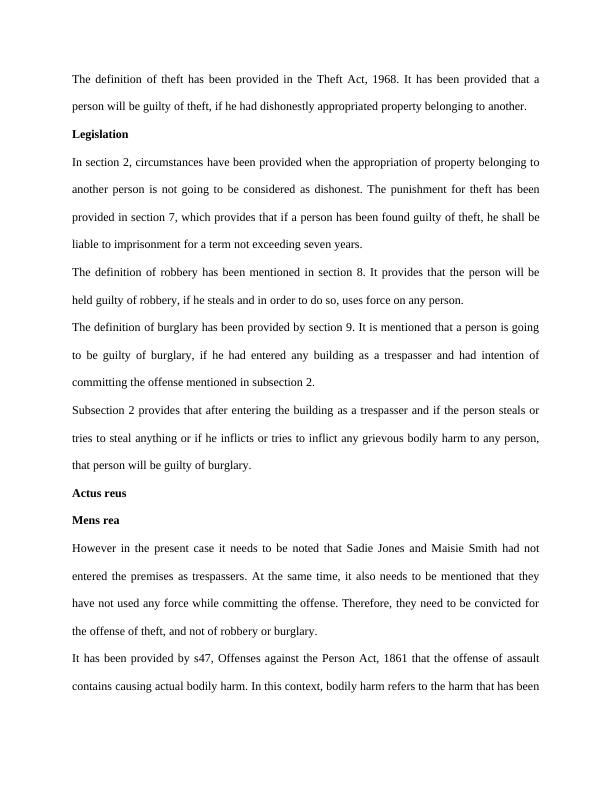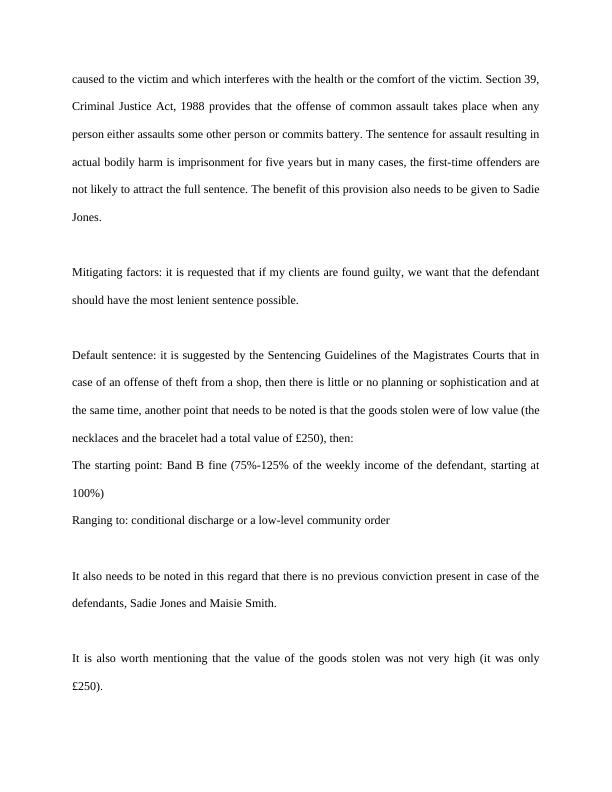Case Study - Theft and Assault
Added on 2022-09-07
7 Pages1475 Words46 Views
Good Morning Sir/Madam, I am appearing before you to represent my clients, Sadie Jones and
Maisie Smith, who have been charged with theft and also of assault and battery. They are
charged of stealing three necklaces and a bracelet from the display of the store priced at £250. At
the same time, Ms. Smith has also been charged of hitting the detective working in the store.
In this case, I want to put to the Court that there are certain mitigating factors that are worthy of
consideration before sentencing.
May I proceed Madam/Sir?
Important elements of the case:
I admit before you that my clients Sadie Jones and Maisie Smith have stolen three necklaces and
a bracelet from the display of the store. When they came out of the store, they were followed by
a detective from the store and apprehended them in the street. It is alleged that Ms. Smith had
kicked the detective which resulted in bruising. It needs to be mentioned that one of the
necklaces was damaged but the store wants to proceed with the case against my clients. The
prosecution seeks damages for attacking the store detective and it is also seeking cost for medical
treatment of the detective.
Break down the different parts
For each offence
Maisie Smith, who have been charged with theft and also of assault and battery. They are
charged of stealing three necklaces and a bracelet from the display of the store priced at £250. At
the same time, Ms. Smith has also been charged of hitting the detective working in the store.
In this case, I want to put to the Court that there are certain mitigating factors that are worthy of
consideration before sentencing.
May I proceed Madam/Sir?
Important elements of the case:
I admit before you that my clients Sadie Jones and Maisie Smith have stolen three necklaces and
a bracelet from the display of the store. When they came out of the store, they were followed by
a detective from the store and apprehended them in the street. It is alleged that Ms. Smith had
kicked the detective which resulted in bruising. It needs to be mentioned that one of the
necklaces was damaged but the store wants to proceed with the case against my clients. The
prosecution seeks damages for attacking the store detective and it is also seeking cost for medical
treatment of the detective.
Break down the different parts
For each offence

The definition of theft has been provided in the Theft Act, 1968. It has been provided that a
person will be guilty of theft, if he had dishonestly appropriated property belonging to another.
Legislation
In section 2, circumstances have been provided when the appropriation of property belonging to
another person is not going to be considered as dishonest. The punishment for theft has been
provided in section 7, which provides that if a person has been found guilty of theft, he shall be
liable to imprisonment for a term not exceeding seven years.
The definition of robbery has been mentioned in section 8. It provides that the person will be
held guilty of robbery, if he steals and in order to do so, uses force on any person.
The definition of burglary has been provided by section 9. It is mentioned that a person is going
to be guilty of burglary, if he had entered any building as a trespasser and had intention of
committing the offense mentioned in subsection 2.
Subsection 2 provides that after entering the building as a trespasser and if the person steals or
tries to steal anything or if he inflicts or tries to inflict any grievous bodily harm to any person,
that person will be guilty of burglary.
Actus reus
Mens rea
However in the present case it needs to be noted that Sadie Jones and Maisie Smith had not
entered the premises as trespassers. At the same time, it also needs to be mentioned that they
have not used any force while committing the offense. Therefore, they need to be convicted for
the offense of theft, and not of robbery or burglary.
It has been provided by s47, Offenses against the Person Act, 1861 that the offense of assault
contains causing actual bodily harm. In this context, bodily harm refers to the harm that has been
person will be guilty of theft, if he had dishonestly appropriated property belonging to another.
Legislation
In section 2, circumstances have been provided when the appropriation of property belonging to
another person is not going to be considered as dishonest. The punishment for theft has been
provided in section 7, which provides that if a person has been found guilty of theft, he shall be
liable to imprisonment for a term not exceeding seven years.
The definition of robbery has been mentioned in section 8. It provides that the person will be
held guilty of robbery, if he steals and in order to do so, uses force on any person.
The definition of burglary has been provided by section 9. It is mentioned that a person is going
to be guilty of burglary, if he had entered any building as a trespasser and had intention of
committing the offense mentioned in subsection 2.
Subsection 2 provides that after entering the building as a trespasser and if the person steals or
tries to steal anything or if he inflicts or tries to inflict any grievous bodily harm to any person,
that person will be guilty of burglary.
Actus reus
Mens rea
However in the present case it needs to be noted that Sadie Jones and Maisie Smith had not
entered the premises as trespassers. At the same time, it also needs to be mentioned that they
have not used any force while committing the offense. Therefore, they need to be convicted for
the offense of theft, and not of robbery or burglary.
It has been provided by s47, Offenses against the Person Act, 1861 that the offense of assault
contains causing actual bodily harm. In this context, bodily harm refers to the harm that has been

caused to the victim and which interferes with the health or the comfort of the victim. Section 39,
Criminal Justice Act, 1988 provides that the offense of common assault takes place when any
person either assaults some other person or commits battery. The sentence for assault resulting in
actual bodily harm is imprisonment for five years but in many cases, the first-time offenders are
not likely to attract the full sentence. The benefit of this provision also needs to be given to Sadie
Jones.
Mitigating factors: it is requested that if my clients are found guilty, we want that the defendant
should have the most lenient sentence possible.
Default sentence: it is suggested by the Sentencing Guidelines of the Magistrates Courts that in
case of an offense of theft from a shop, then there is little or no planning or sophistication and at
the same time, another point that needs to be noted is that the goods stolen were of low value (the
necklaces and the bracelet had a total value of £250), then:
The starting point: Band B fine (75%-125% of the weekly income of the defendant, starting at
100%)
Ranging to: conditional discharge or a low-level community order
It also needs to be noted in this regard that there is no previous conviction present in case of the
defendants, Sadie Jones and Maisie Smith.
It is also worth mentioning that the value of the goods stolen was not very high (it was only
£250).
Criminal Justice Act, 1988 provides that the offense of common assault takes place when any
person either assaults some other person or commits battery. The sentence for assault resulting in
actual bodily harm is imprisonment for five years but in many cases, the first-time offenders are
not likely to attract the full sentence. The benefit of this provision also needs to be given to Sadie
Jones.
Mitigating factors: it is requested that if my clients are found guilty, we want that the defendant
should have the most lenient sentence possible.
Default sentence: it is suggested by the Sentencing Guidelines of the Magistrates Courts that in
case of an offense of theft from a shop, then there is little or no planning or sophistication and at
the same time, another point that needs to be noted is that the goods stolen were of low value (the
necklaces and the bracelet had a total value of £250), then:
The starting point: Band B fine (75%-125% of the weekly income of the defendant, starting at
100%)
Ranging to: conditional discharge or a low-level community order
It also needs to be noted in this regard that there is no previous conviction present in case of the
defendants, Sadie Jones and Maisie Smith.
It is also worth mentioning that the value of the goods stolen was not very high (it was only
£250).

End of preview
Want to access all the pages? Upload your documents or become a member.
